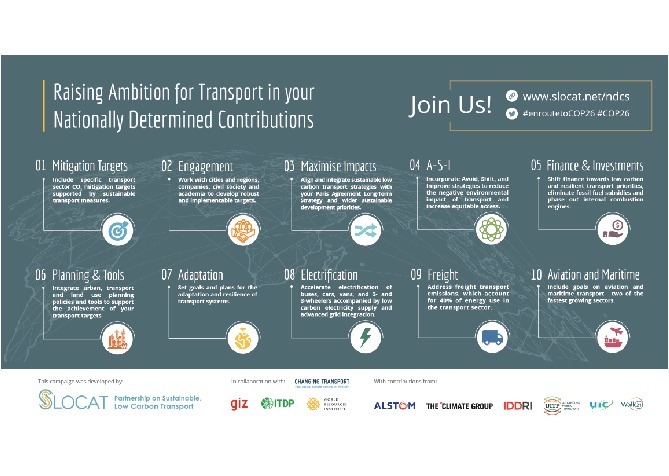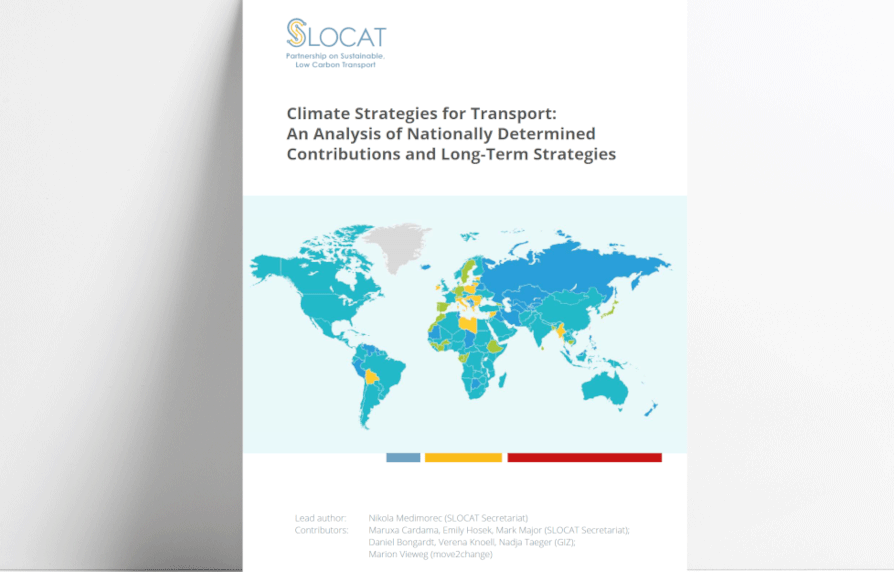
The NDCs Hall of Fame by SLOCAT
The NDCs Hall of Fame by SLOCAT puts the spotlight on how and to what extent countries are incorporating transport ambition and action in the second generation of Nationally Determined Contributions (NDCs) submitted so far by countries in the framework of the Paris Agreement on Climate Change. By doing this, we aim to illustrate how countries can enhance the transport dimension of their NDCs and hence enable passenger and freight transport systems for equitable, decarbonised, resilient pathways.
The NDCs Hall of Fame by SLOCAT is based on the SLOCAT Ten Recommendations to Raise Ambition for Transport in NDCs and the data from the SLOCAT-GIZ NDC Transport Tracker (as of 10 November 2023). Read the assessment methodology below and contact Nikola Medimorec for more information.
The best second-generation NDCs on Transport

The NDCs Hall of Fame by SLOCAT concludes with awards to the best NDCs in terms of transport ambition and action.

The NDCs of Andorra, Guinea, Seychelles, Sri Lanka, Uganda and United Arab Emirates receive 4 stars as the best-performing in support of sustainable, low carbon transport.
The ambition to transform transport systems is reflected in these NDCs through a comprehensive set of actions and targets. They cover transport targets and include mitigation actions, as well as freight transport actions. They also feature actions across the Avoid-Shift-Improve framework, including sustainable urban transport walking and cycling, and electric mobility.
All 6 NDCs outline detailed actions to support their transport greenhouse gas emission mitigation targets. The NDCs by Andorra, Seychelles and United Arab Emirates connect transport activities to urban planning; and tailor actions for public transport, walking and cycling, while also intending to reduce the fossil fuel dependency through the introduction of zero-emission vehicles.
Andorra’s NDC mandates all public and private entities to develop and actualise mobility plans for all their personnel; in line with the National Strategy for Sustainable Mobility and included a target to offer free public transport services to all citizens starting in 2022. Guinea’s NDC shares a list of rail and urban transport projects, including available information on future transport capacity, construction costs and estimated emission reductions for those projects. Seychelles’ NDC outlines a vision of future transport beyond mitigation by including plans to develop and implement a transport adaptation strategy and risk assessment. Sri Lanka’s NDC reviews achievements since their first NDC and describes the efforts put into the transport NDC actions. Uganda’s NDC aims at revising design codes, regulations and guidelines to climate-proof strategic transport infrastructure. The NDC by the United Arab Emirates emphasises mixed-used development to reduce the demand for transport and features actions on infrastructure expansions and the development of standards for electric, hydrogen and autonomous vehicles.

The NDCs of Bangladesh, Burkina Faso, Dominica, El Salvador, Mauritania, Samoa and South Sudan receive 3 stars. All of them feature transport greenhouse gas mitigation targets and a strong focus on Shift and Improve actions for passenger transport.
All 7 NDCs contain detailed transport actions. However they do not cover urban transport actions (i.e. public transport, walking and cycling) or freight transport in the same detail as the 4-star best-performing NDCs. The NDCs by Samoa and Dominica feature transport greenhouse gas mitigation targets for both land and maritime transport. The NDCs by Dominica, El Salvador and Samoa include actions linking transport to renewable energy. The NDC by Mauritania features several infrastructure expansions (urban rail and intercity rail), measures to restrict import of used vehicles and incentivise more energy-efficient vehicles. El Salvador’s NDC intends to implement public transport, walking and cycling actions.

The NDCs of Belize, Cabo Verde, Colombia, Egypt, Jordan and Liberia receive 2 stars.
These NDCs present a mix of different strengths. Belize features action to reduce fossil fuel use, improve fuel efficiency, and adopt hybrid and electric vehicles for use in the public and private transport sector. Cabo Verde’s NDC contains electric mobility actions, while also aiming at advancing active mobility and examining opportunities for sustainable maritime transport. Egypt’s NDC aims to develop high-quality public transportation to reduce private travel in both the freight and passenger transportation sectors. Bus rapid transit, electric buses and compact cities actions are included in Jordan’s NDC. Liberia’s NDC commits to reduce transport greenhouse gas emissions by 15.1% below business-as-usual levels by 2030 through the completion of several transport projects. Colombia’s NDC features a strong diversity of actions on cycling, public transport, railways, taxis, trucks and walking.

The NDCs of Albania, Barbados, Grenada, Japan, Mauritius, and Nepal receive one star.
Albania’s NDC features targets on increasing the modal share of public transport, as well as on shifting freight transport from road to rail. Barbados’s NDC focuses on sustainable urban transport through the transition to a fully electrified public bus fleet by 2030. The NDC by Grenada features a transport GHG mitigation target, however, it also recognises that the current mitigation measures, including the introduction of gasoline taxes, biofuel blends, and fuel efficiency standards, are not adequate to meet the target of 20% reduction in transport emissions by 2025. The NDC by Japan aims to reduce the GHG emissions from transport from 224 million tonnes CO2 in 2013 to 146 million tonnes CO2 by 2030. Mauritius’ NDC features extension of the light rail network as part of the national strategy to modernise and upscale the public transport system, and phasing out of subsidies and incentives for the importation of diesel buses while increasing the subsidies for the purchase of electric vehicles. Nepal’s NDC outlines 2025 and 2030 targets for sales of electric cars, buses, two- and three-wheelers.
You can read about the detailed methodology for this assessment here at the bottom of the page . This exercise presents the following limitations:
1) The assessment examines if a NDC covers a parameter and in most cases it does not assess the quality of the given parameter. Only the transport greenhouse gas mitigation targets have been assessed in terms of their ambition. A NDC might cover very few parameters that are counted for the scoring, but the content could be very ambitious.
2) This assessment only looks at 6 major categories (see top of page). There are several more aspects that come into play to determine a robust NDC in terms of ambition and action for sustainable, low carbon transport (see the SLOCAT Ten Recommendations to Raise Ambition for Transport in NDCs).
3) All NDCs are evaluated in the same manner without the country and development context being accounted for.
4) It must be underscored that NDCs do not always reflect all the transport actions that are planned or implemented by a given country. National transport development strategies and policies, and infrastructure plans often outline more activities on passenger and freight transport.
Why are we not awarding 5 stars to any NDC submitted so far?
The awarded NDCs are showing relevant ways in which to enable the transformation of passenger and freight transport systems for equitable, decarbonised and resilient pathways. They illustrate positive trends compared to the first-generation of NDCs. However it is important to remember that overall, second-generation NDCs are not sufficient to meet the Paris Agreement goals. The UNFCCC Synthesis Report found that not only is the level of ambition in second-generation NDCs insufficient to achieve the goals of the Paris Agreement. It will, in fact, imply a further increase of greenhouse gas emissions of around 16% by 2030. Equally, across the board, NDCs are not enabling the transformation of transport systems that is required. Read more about the strengths and gaps of climate strategies in SLOCAT’s Climate Strategies for Transport: An analysis of Nationally Determined Contributions and Long-Term Strategies and conduct your own research through the SLOCAT-GIZ NDC Transport Tracker.
The SLOCAT Partnership compiled recommendations to raise ambition for transport in NDCs to align transport with the Paris Agreement and the 2030 Agenda for Sustainable Development. These recommendations include practical steps to ensure that the way that climate strategies are developed and implemented maximises climate action in transport. Explore here the SLOCAT Ten Recommendations to Raise Ambition for Transport in NDCs.
Do NDCs include ambitious measures that support passenger and freight transport systems for equitable, decarbonised, resilient pathways?
In 2022, SLOCAT released the Good, the Bad and the Ugly of NDCs in relation to:
Transport greenhouse gas mitigation targets
The GoodThe percentage of countries including transport GHG mitigation targets has more than doubled between first- and second-generation NDCs. Although most NDCs lack direct transport GHG mitigation targets, many NDCs include other indirect targets; such as the European Union’s strong target on CO2 emission performance standards for new cars and trucks. |
The BadExcept for Japan, no other major transport emitters have included transport GHG mitigation targets in their NDCs. This leaves over 90% of national transport emissions not covered under any sector-specific target on emissions reductions. |
The UglyEven if the transport GHG mitigation targets of the current NDCs were met, they would, at best, only make a small dent in the overall increase in transport emissions that is projected. Transport emissions must decrease by two-thirds below 2019 levels by 2050 to support achievement of Paris Agreement goals. |
Moving forwardIn order to have a chance at achieving Paris Agreement goals, countries must must significantly increase the ambition to reduce emissions from transport in their NDCs. This includes setting specific transport targets for GHG mitigation aligned with the 1.5°C target. |
Transport mitigation and adaptation actions
The GoodSecond-generation NDCs are embracing a wider portfolio of transport mitigation and adaptation actions. They feature more than twice as many actions compared to first-generation NDCs. |
The BadTransport actions in NDCs are often presented in very general, vague terms. This is especially the case for transport adaptation actions. |
The UglyNDCs often contain very general statements of intent which lack specificity on how targets and actions will be implemented. They miss the opportunity to provide a clear, shared blueprint for all stakeholders in a country to support implementation. |
Moving forwardCountries should strive to include more specific transport mitigation and adaptation actions in their NDCs. In doing so, they should link these actions to specific implementation plans, such as a national transport strategy, for instance. |
Freight transport actions
The GoodOne-third of all second-generation NDCs include explicit freight-related actions. This is a positive trend, given that freight transport is seen as one of the most hard-to-abate sectors of transport. | The BadComprehensive freight decarbonisation solutions – such as introducing zero-emission trucks, improving efficiency and shifting freight transport from road to railways or waterways – are still largely missing from NDCs. |
The UglyTwo-thirds of second-generation NDCs fail to include plans to reduce freight emissions, despite the sector’s overall significant and growing contributions to GHG emissions. Freight transport currently accounts for 40% of greenhouse gas emissions in transport. | Moving forwardCountries should include specific targets and actions to reduce emissions from freight transport in their NDCs. These actions often involve different stakeholders and require different strategies, compared to the actions aimed at reducing passenger transport emissions. |
Download the social media card on freight transport actions here.
Integrated, inter-modal and balanced Avoid-Shift-Improve strategies
The GoodNDCs by Cabo Verde, Jordan, Sri Lanka and Tajikistan include comprehensive sets of transport actions that embrace the full spectrum of Avoid-Shift-Improve strategies. Such a comprehensive approach has the potential to deliver multiple social, economic, and environmental benefits, in addition to reducing transport emissions. |
The BadThe potential benefit of employing Avoid and Shift actions to decarbonise the transport sector is largely untapped in second-generation NDCs. Only 4% of transport mitigation actions in the NDCs are classified as Avoid actions, while Shift makes up 25% of all transport actions in the NDCs. The large majority of transport actions in the NDCs (58%) focus on Improving current systems. |
The UglyTrends over the years show that transport actions in the NDCs are narrowing towards an exacerbated focus on Improve actions (namely electrification) at the expense of other types of actions which can promote more holistic, sustainable and impactful approaches to equitable, decarbonised resilient transport. |
Moving forwardCountries should consider in their NDCs the full spectrum of transport measures to reduce emissions and increase equitable access to resilient transport systems. More holistic and sustainable transport decarbonisation approaches include a robust mix of Avoid-Shift-Improve strategies in the interest of systemic transformations; rather than simply favouring improvements to current systems. |
Public transport, walking and cycling actions
The GoodNearly half of second-generation NDCs feature actions that support at least one of the following: public transport, walking and cycling. These actions have the potential to simultaneously support deep emission mitigation and generate widespread social benefits. |
The BadActions in NDCs related to public transport, walking and cycling tend to be isolated and/or superficial. The full mitigation and social potential of these actions is not being realised, as they are often not adequately prioritised or integrated into broader strategies. |
The UglyNDCs largely fail to recognise not only the mitigation benefits but also the significant benefits to health, job creation and mobility access that sustainable transport modes such as public transport, walking and cycling can provide. This may result in less interest, support and funding for these high-impact measures. |
Moving forwardNDCs provide an opportunity to not only reduce emissions, but also support holistic sustainable development pathways. Countries should consider integrating in their NDCs actions on public transport, walking and cycling that not only substantially reduce emissions, but also enable multiple societal benefits. |
Transport electrification actions
The GoodCommitments to electrify transport have rapidly gained momentum in recent years, with over 50% of second-generation NDCs now including content on electric mobility. Electrification can be an important enabler in reducing the transport sector’s dependence on fossil fuels, if coupled with renewable energies strategies. | The BadTransport electrification actions in NDCs primarily focus on personal road vehicles. This misses out on the significant opportunities to electrify shared transport modes, such as buses, as well as widely used two- and three-wheeled vehicles. |
The UglyThis stronger focus on transport electrification in NDCs has taken attention away from other actions that are critical to the systemic transformations towards sustainable, decarbonised transport, especially related to public transport improvements. | Moving forwardTransport electrification actions in the NDCs should be part of holistic strategies for equitable, decarbonised, resilient transport. Besides, they should go beyond the electrification of private vehicles to also include buses, trucks, vans and two- and three-wheeled vehicles. These actions should be supported by plans for low-carbon electricity supply and advanced grid integration. |
Download the social media card on transport electrification actions here.
The assessment is based on the SLOCAT Ten Recommendations to Raise Ambition for Transport in NDCs, with data from the SLOCAT-GIZ NDC Transport Tracker, a database on ambition, targets and policies in NDCs and LTS of the Paris Agreement. Contact Nikola Medimorec for further information.
Follow us on Twitter and stay tuned via #TransportinNDCs for more content on NDCs and transport!
Assessment methodology
NDCs have been scored according to their relative level of transport climate ambition and the comprehensiveness of actions included. Specifically, the NDCs have been assessed based on a weighted score across the following 6 categories, with more weight given to ambition and actions that hold a higher potential to support sustainable, low carbon transport:
Transport GHG mitigation targets (weight = 3):
This category is scored based on the inclusion of a direct transport mitigation GHG target or indirect transport mitigation target(s) within a countries’ NDC. Bonus points are awarded based on the level of ambition of the transport target, specifically to those countries that have included a transport GHG mitigation target aiming to reduce absolute transport emissions, not just reduce emission growth intensity. This category is regarded as the most important element of a strong transport NDC and therefore holds the highest weight among the 6 categories.
- 20 bonus points are awarded to NDCs which include a direct transport GHG mitigation target aimed at reducing absolute emissions (e.g., transport CO2 emissions to be reduced from 200 million tonnes per year to 150 million tonnes per year by 2030);
- 10 points are awarded to NDCs that features any kind of direct transport GHG mitigation target (e.g., transport CO2 emissions to reduce 20% below the business-as-usual scenario by 2030);
- 10 additional points are awarded to NDCs that feature only indirect transport targets (e.g., targets on e-mobility, modal shift, vehicle efficiency etc.).
Transport mitigation and adaptation actions (weight = 2):
This category measures the quantity of transport actions included in a country’s NDC, rewarding those NDCs with a relatively higher number of transport mitigation and adaptation actions. It is regarded as an important category because it will be impossible to establish a resilient, low carbon transport system without implementing various actions that tackle different aspects of transport mitigation.
- 10 points are awarded to NDCs that include an above-average number of transport mitigation actions (anything over 5);
- 10 points are awarded to NDCs with an above-average number of transport adaptation actions (anything over 2).
Integrated, inter-modal and balanced Avoid-Shift-Improve strategies (weight = 1.5):
This category evaluates to what extent countries are including Avoid and Shift transport actions in their NDCs. While the NDCs have a strong focus on Improve actions, growing evidence shows that Avoid and Shift strategies can account for 40-60% of transport emission reductions, at lower costs than Improve strategies. A balanced set of Avoid, Shift and Improve actions in an NDC will enable a transformation of a transport system.
- 20 points are awarded to NDCs that have combined more Avoid and Shift actions than Improve actions.
- 10 points are awarded to NDCs that contain any Avoid or Shift actions.
Public transport, walking and cycling actions (weight = 1):
This category evaluates the extent to which a country’s NDC includes actions in support of public transport, walking and cycling. Activities in these areas are important to support holistic sustainable development pathways. The score of this category is not enhanced by a higher weight because many of these actions are already reflected in the Avoid-Shift-Improve category.
- 20 points are awarded to NDCs with actions in support of all 3 modes.
- 10 points are awarded to NDCs that cover at least one of the aforementioned modes.
Transport electrification actions (weight = 1):
This category evaluates the extent to which a country’s NDC includes electric mobility targets and actions. Transport electrification actions in the NDCs should be part of holistic strategies for equitable, decarbonised, resilient transport.
- 20 points are awarded to NDCs that include electric mobility targets as well as actions.
- 10 points are awarded to NDCs that include electric mobility actions (but no target).
About the methodology and awardees
This methodology was developed by the SLOCAT Secretariat with the intention to score all second-generation NDCs in an objective manner. Second-generation NDCs submitted until 10 November 2023 are included in the assessment. These data are based on the SLOCAT-GIZ NDC Transport Tracker. 4 groups (from 4-star transport NDCs to one-star transport-NDCs) have been identified for the best-performing NDCs according to their score. The thresholds have been set where the difference to the score was significantly larger to the next lower-scoring country than the higher-scoring countries. The figure below shows the final scores for all second-generation NDCs that scored more than zero points:
SLOCAT releases assessments and analyses to enable collaborative knowledge and action for sustainable, low carbon transport. While SLOCAT assessments and analyses have benefited from the considerations and input from the SLOCAT community, they do not necessarily represent a consensus among partners on any given point. Although the information given in this assessment is the best available to the authors at the time, SLOCAT and its partners cannot be held liable for its accuracy and correctness.


